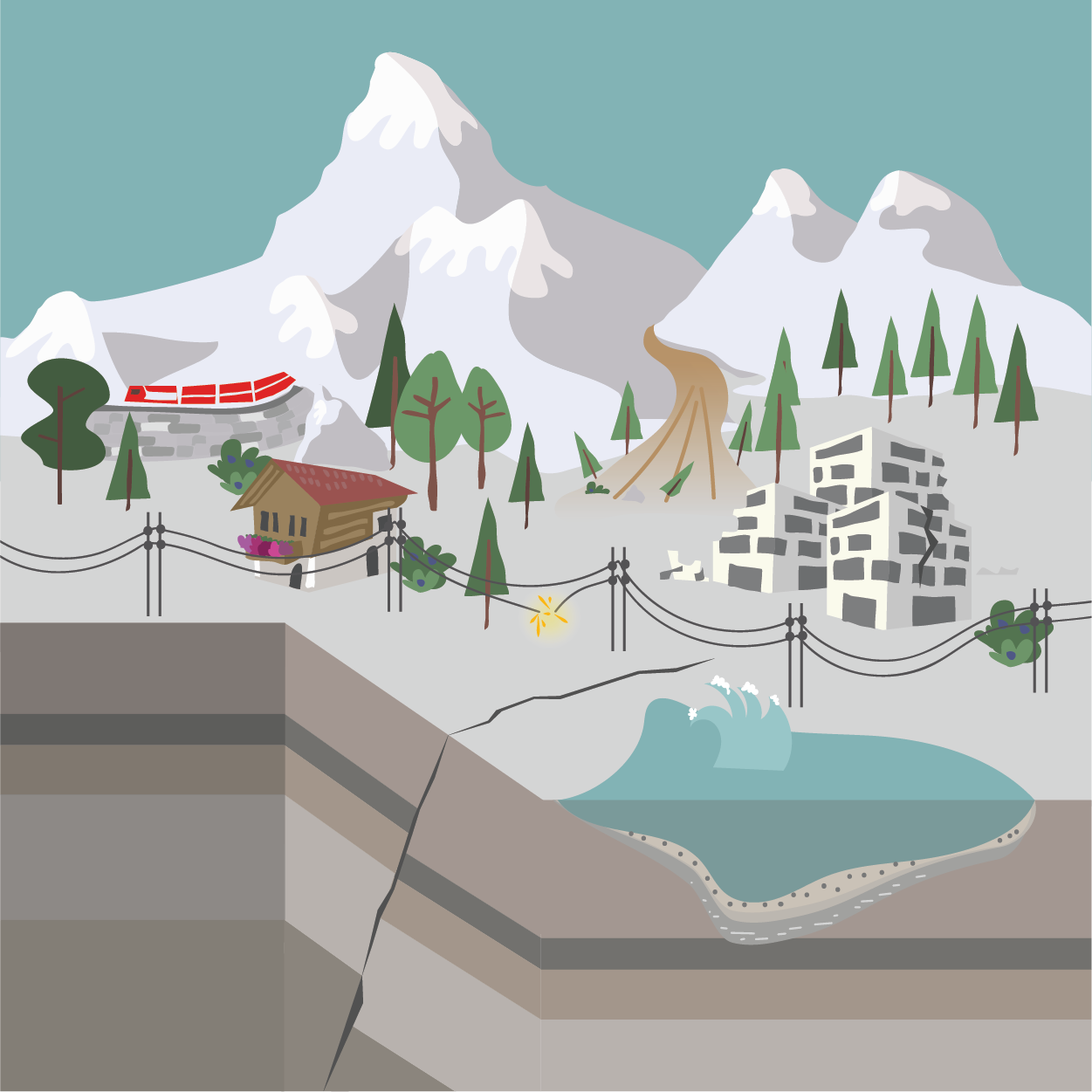The earthquake hazard and risk section supports the SED in its mission to mitigate earthquake risks. This section develops and regularly updates local and national hazard and risk models in probabilistic and deterministic frameworks, and contributes to the European models. This typically includes all model components from earthquake catalogues, active faults, seismogenic source models, earthquake rate forecasts, ground motion modelling and estimation, local amplification models, exposure and vulnerability of the built environment, consequence models, uncertainty quantification, technical integration, and software development.

The latest models are the earthquake risk model for Switzerland (ERM-CH23), built upon the national seismic hazard model (SUIhaz15) and a national soil amplification model, a local high-resolution risk model for the canton of Basel-Stadt (ERM-BS24), and the European Seismic Hazard and Risk Models (ESHM20 and ESRM20), released in 2022. The section focuses on creating useful, understandable, and accessible products for diverse stakeholders, including the public, cantonal and federal governmental agencies, and engineers.
The section integrates seismic hazard products into Swiss engineering practices, such as the Swiss building code SIA 261 and the dam regulations. This includes implementing the latest national seismic hazard model, defining elastic response spectra, soil classification, de-aggregation and waveform databases. They also participate in developing national regulations such as those for local seismic hazard assessment and developing local seismic hazard maps (microzonation). The Swiss Federal Nuclear Safety Inspectorate (ENSI) also relies on their site-specific studies.
In close collaboration with the monitoring, alerting and analysis section, the group studies earthquake-induced phenomena, including the triggering of rock-fall, landslides, soil liquefaction, and lake tsunamis caused by the failure of sediment slopes in lakes. They analyse the response of these specific surficial geological structures to ambient vibrations and earthquake ground motion, estimate their volumes and internal structure, and model the process and consequences of sediment and slope failures.
In addition, the section engages in teaching and outreach, helping to raise awareness about earthquake risks and mitigation strategies. It collaborates with various universities and participates in public lectures, making sure that research findings reach a broad audience.
Professor Dr. Donat Fäh heads the section, which is divided into three research groups.
Led by Dr. Paolo Bergamo, this group develops various methods to estimate site-specific amplification for local seismic hazard assessments. These methods rely on geophysical measurements and earthquake recordings, combining both empirical and numerical simulations derived from geophysical models. The group produces detailed models of ground motion that inform risk mitigation strategies. Their work is essential for updating national standards, such as those for building codes and dam regulations, and for producing accurate local seismic hazard assessments. Collaborating with ENSI, the group is mandated to update the Swiss stochastic ground motion model and develop new tools to estimate ground motions at depth from surface earthquake recordings, e.g. for the proposed nuclear waste repository.
Under the leadership of Dr. Laurentiu Danciu and Dr. Philippe Roth, this group designs and implements seismic hazard and risk models at various scales, from site-specific to national and regional. It technically implements the components and models and handles the computational aspects. The group has played a key role in the development of Switzerland’s national seismic hazard model (SUIhaz15) and the earthquake risk model (ERM-CH23), which offer valuable insights for decision-makers, engineers, and the public. On a larger scale, they lead efforts in developing European seismic hazard models, such as ESHM20, and the earthquake models of the Middle East (i.e. EMME14). The group collaborates with various stakeholders and entities on natural and anthropogenic earthquake hazards and risk assessments, including insurance and reinsurance companies, engineering offices, and the Swiss Financial Market Supervisory Authority (FINMA).
The group hosts the secretary and web presence of the European Facilities for Earthquake Hazard and Risk (EFEHR, www.efehr.org), providing access to national and regional hazard models. The group also plays an active role in developing earthquake rapid impact assessment tools and operational services to support mitigation actions in Switzerland. In addition, it represents Switzerland on behave of the State Secretariat for Education, Research and Innovation (SBFI) within the GEM Foundation in Pavia (Italy) and contributes to the Global Earthquake Model and development of the OpenQuake software.
Led by Dr. Franziska Glüer and Dr. Valentin Gischig, the geo risks group integrates geophysical measurements, seismic monitoring, numerical modelling, and engineering-geological and geotechnical techniques to investigate earthquake-induced hazards. Their research covers rockfalls and landslides, liquefaction, and landslide-induced lake tsunamis. The group develops geophysical site characterisation techniques for mountain slopes and lakes as well as tools to monitor changes in the seismic response, which are related to changes in the internal structure. Their work involves the monitoring of active slope instabilities across Switzerland, for example at Brienz/Brinzauls, as well as slow-moving landslide areas in Switzerland. The group also focuses on developing methods to predict and monitor liquefaction at sites in Switzerland. In addition, the group is also engaged in risk-related research at the BedrettoLab with a focus on modelling hydro-mechanical processes.